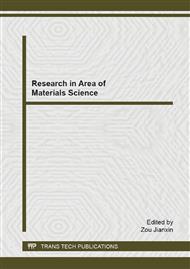[1]
T. J. Droozda, and Wick, C. (Eds), Tool and Manufacturing Engineers Handbook, Vol. 1, Machining, SME, Dearborn, pp.1-52.
Google Scholar
[2]
N. Satheesh Kumar, Ajay Shetty, Ashay Shetty, Ananth , Harsha Shetty, ffect of spindle speed and feed rate on surface roughness of Carbon Steels in CNC turning , Procedia Engineering 38 ( 2012 ) 691 – 697.
DOI: 10.1016/j.proeng.2012.06.087
Google Scholar
[3]
M. N. Islam, Member, IAENG and Brian Boswell, An Investigation of Surface Finish in Dry Turning, Proceedings of the World Congress on Engineering 2011 Vol I, WCE 2011, July 6 - 8, 2011, London, U. K.
Google Scholar
[4]
Tonshoff H, Arendt C, Ben Amor R. Cutting of hardened steel. CIRP Annals Manufacturing Technology 2000; 49: 547–66.
DOI: 10.1016/s0007-8506(07)63455-6
Google Scholar
[5]
Griffiths BJ. Mechanisms of white layer generation with reference to machining and deformation processes. Journal of Tribology—Transactions of the ASME 1987; 109: 525–30.
DOI: 10.1115/1.3261495
Google Scholar
[6]
Akcan S, Shah S, Moylan SP, Chhabra PN, Chandraseksar S, Yang HTY. Formation of white layers in steels by machining and their characteristics. Metallurgical and Materials Transactions A 2002; 33: 1245–54.
DOI: 10.1007/s11661-002-0225-z
Google Scholar
[7]
Ramesh A, Melkote SN, Allard L, Riester L, Watkins TR. Analysis of white layers formed in hardturning of AISI52100 steel. Materials Science and Engineering A2005; 390: 88–97.
DOI: 10.1016/j.msea.2004.08.052
Google Scholar
[8]
Virginia Garcı´a Navas , Oscar Gonzalo, Ion Bengoetxea , Effect of cutting parameters in the surface residual stresses generated by turning in AISI 4340 steel , International Journal of Machine Tools & Manufacture 61 (2012) 48–57.
DOI: 10.1016/j.ijmachtools.2012.05.008
Google Scholar
[9]
K. A. Risbood, U.S. Dixit, A.D. Sahasrabudhe, Prediction of surface roughness and dimensional deviation by measuring cutting forces and vibrations in turning process, J. Mater. Process. Technology, vol. 132, p.203–214, January (2003).
DOI: 10.1016/s0924-0136(02)00920-2
Google Scholar
[10]
C. X. Feng, An experimental study of the impact of turning parameters on surface roughness, In Proceedings of the 2001, Industrial Engineering Research Conference, Paper No. (2036).
Google Scholar
[11]
R. Suresh , S. Basavarajappa , V.N. Gaitonde , G.L. Samuel, Machinability on hardened AISI 4340 steel using coated carbide insert , Int. Journal of Refractory Metals and Hard Materials 33 (2012) 75–86.
DOI: 10.1016/j.ijrmhm.2012.02.019
Google Scholar
[12]
J.D. Thiele, S.N. Melkote, Effect of cutting edge geometry and workpiece hardness on surface generation in the finish hard turning of AISI52100 steel, Journal of Materials Processing Technology 94 (2-3) (1999) 216 –226.
DOI: 10.1016/s0924-0136(99)00111-9
Google Scholar
[13]
E. Capello, P. Davoli, G. Bassanini, A. Bisi, Residual stress and surface roughness in turning, Journal of Engineering Materials and Technology 121 (3) (1999) 346 – 351–TASME.
DOI: 10.1115/1.2812385
Google Scholar


